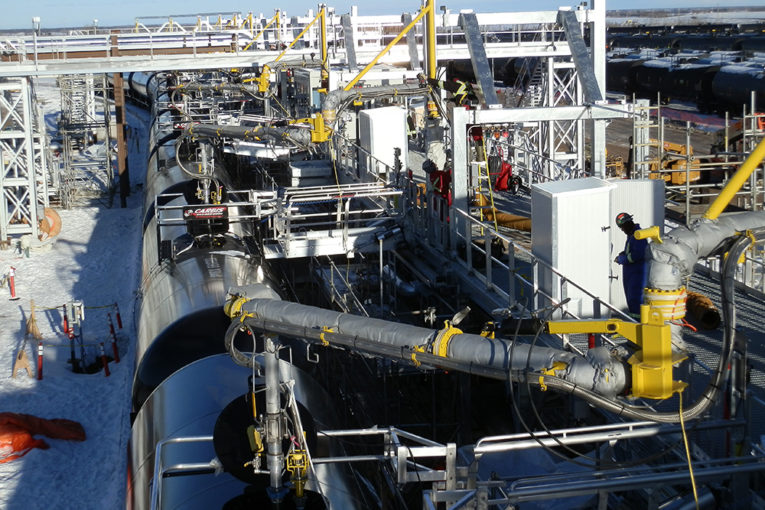
Stranded Canadian crude is waiting for trains to take it to U.S. refineries.
A rail terminal near Edmonton that oilsands producer Cenovus Energy Inc. bought for $75 million sits underutilized just when it’s most needed. The Bruderheim crude-by-rail facility is operating below its potential because of a shortage of locomotives, the company said last week.
Cenovus’ situation isn’t unique. After spending hundreds of millions of dollars building rail terminals able to handle more than a million barrels a day of oil, Canadian crude producers are discovering that all the loading capacity in the world isn’t sufficient if rail companies don’t provide enough locomotives, conductors and track space to transport the oil.
“Everyone kind of fell into the train of thought, that when they needed the rail resources from the rail companies that they would be there,” Mike Walls, Genscape Inc. analyst, said in phone interview. “It’s been frustrating for crude-by-rail shippers.”
Heavy Western Canadian Select, a crude benchmark, has traded more than $20 a barrel below West Texas Intermediate since Dec. 8 after TransCanada Corp.’s Keystone pipeline shut and then resumed operation at reduced pressure following an oil spill. The shutdown came as Suncor Energy Inc.’s new Fort Hills’ oil sands mine was set to begin ramping up. The steep discount for the Canadian crude pushed Cenovus to curtail production.
Western Canadian crude production will exceed the pipeline capacity to carry it away by 338,000 barrels a day by the end of the year, about three times more than December 2017, according to Genscape. Canada’s railroad companies have been slow to respond as they struggle with a harsh winter and large numbers of grain shipments.
The USD Group LLC’s terminal in Hardisty, Cenovus’ Bruderheim terminal and the Kinder Morgan Inc./Imperial Oil Ltd. Edmonton terminal are shipping less than one-third of their combined capacity.
Crude shippers began investing in crude-loading terminals early this decade when oil prices were higher and pipelines weren’t keeping pace with growing production. Producers cut rail shipments when oil plunged in 2014 and pipeline capacity opened up. Now, with oil prices recovering and pipeline space again limited, rail companies, once burned, are now demanding longer-term commitments.
Canadian National Railway Co. now expects a minimum 12-month agreement from oil shippers, Jean-Jacques Ruest, interim chief executive officer, said at a conference March 14.
Oil companies “would get married with pipelines, but they only date the railroad,” he said.
Canadian Pacific Railway Ltd. said the surge in crude demand came eight to ten months earlier than anticipated and that, in a few years, newly approved pipelines will carry the crude that will move by rail now, according to a posting on its website. “It is difficult to justify investing in long-life assets like rail and locomotives based on short-term demand.”
Torq Energy Logistics Ltd.’s six terminals in Saskatchewan and Alberta are transporting about 50,000 barrels a day, below capacity, Jarrett Zielinski, chief executive officer said in a March 15 phone interview. Torq has been using its fleet of 275 tanker trucks to carry medium and heavy crude across the U.S. border because of the glut, he said.
USD is working with railroads to reach “full operational capacity” at its Hardisty terminal by the second quarter, Meg Martin, spokeswoman, said in an email. Canadian National has signed take-or-pay agreements that will begin in the second half of the year at a pricing that’s “above capital cost,” Ruest said earlier this month.
A Canadian Pacific Railway Ltd. train transporting oil leaves Hardisty, Alta.
“Nearly all” of 130 leased locomotives Canadian National secured earlier this year are in service and “we continue to hire hundreds of conductors and are preparing for a record $3.2 billion capital program,” spokesman Patrick Waldron said in an email.
“In the past, I think producers were very cautious or hesitant to make long-term commitments to shipping by rail,” Torq’s Zielinski said. “The current state of affairs has maybe adjusted that position somewhat.”
Bloomberg.com
You can read more of the news on source
